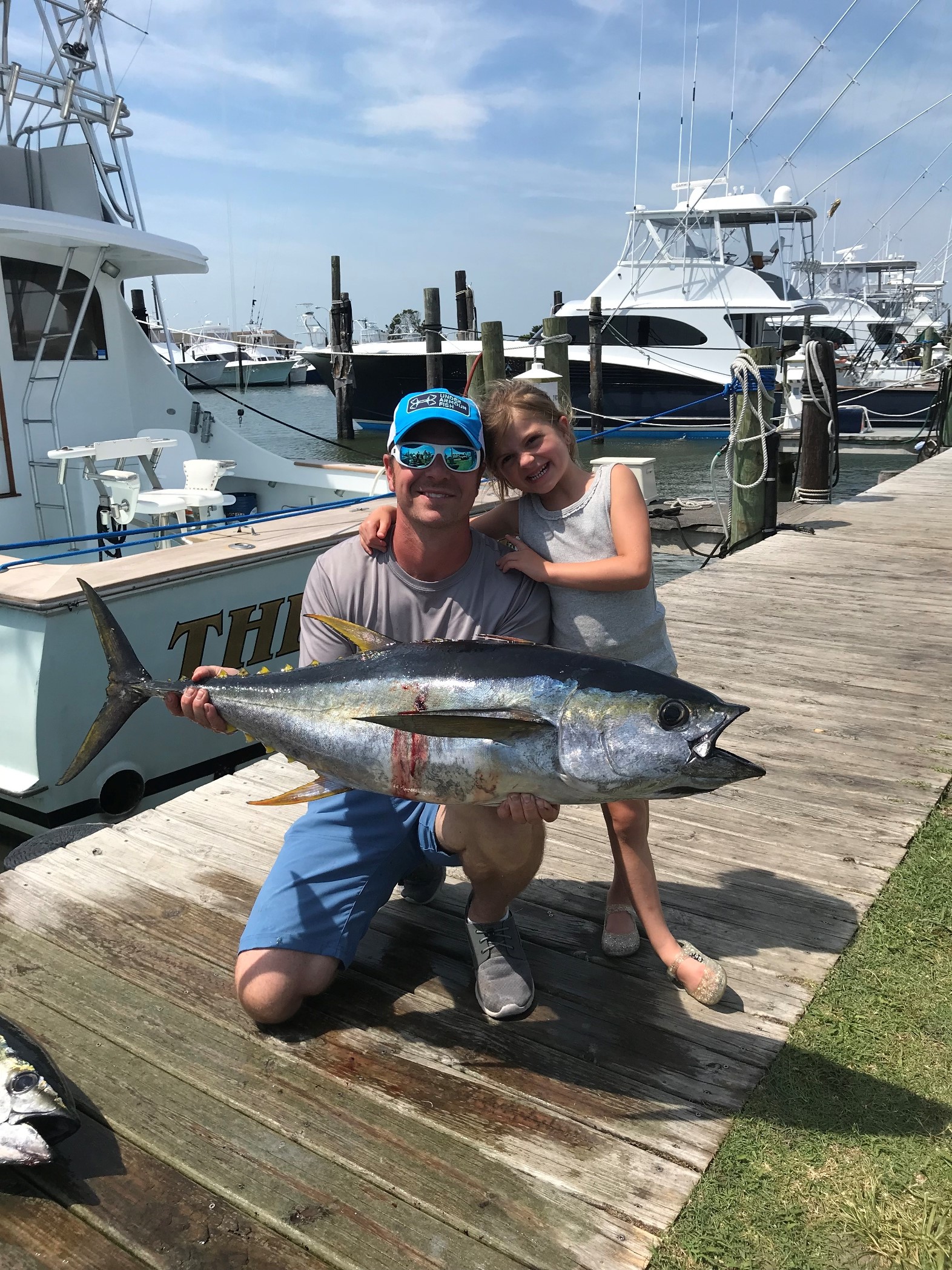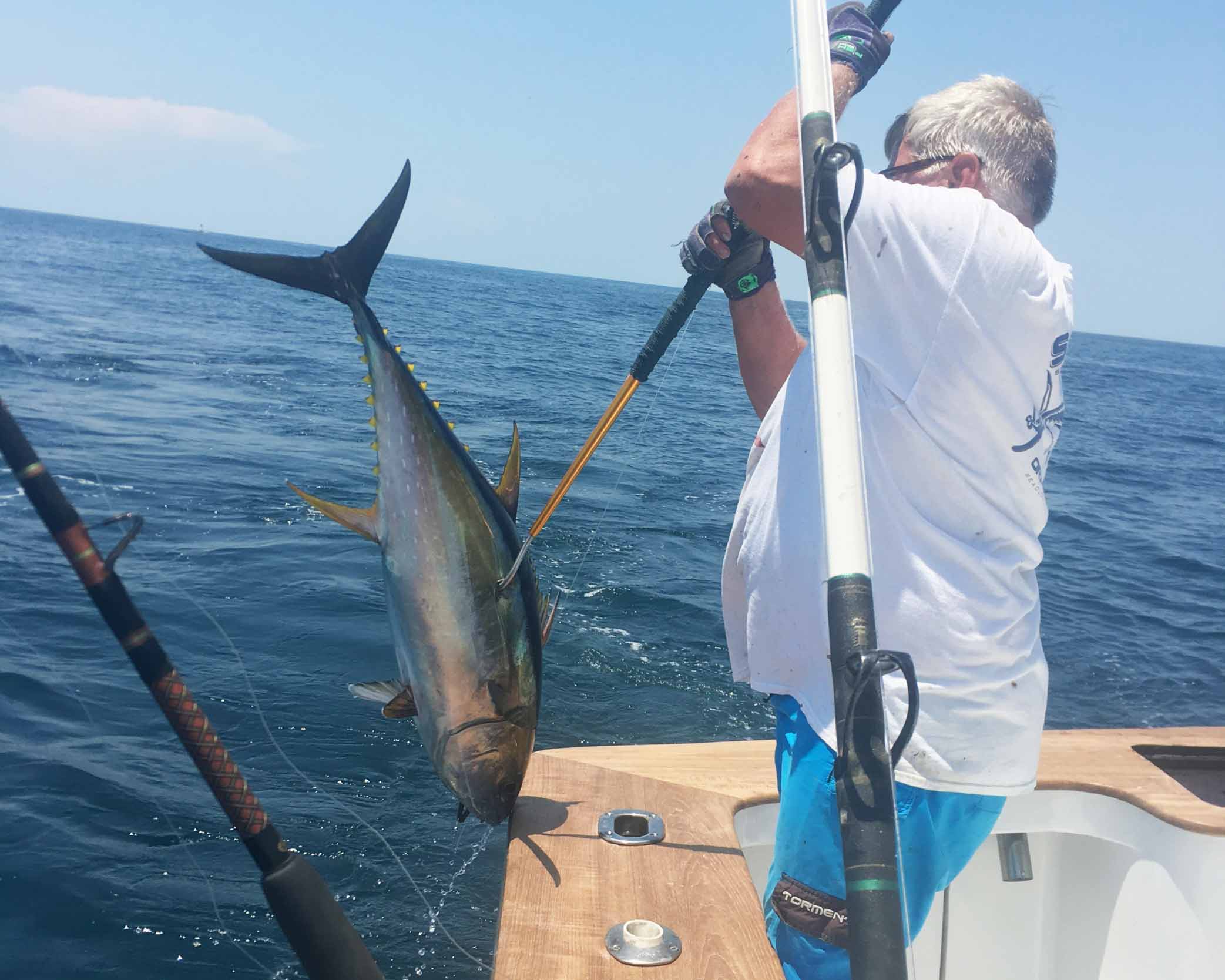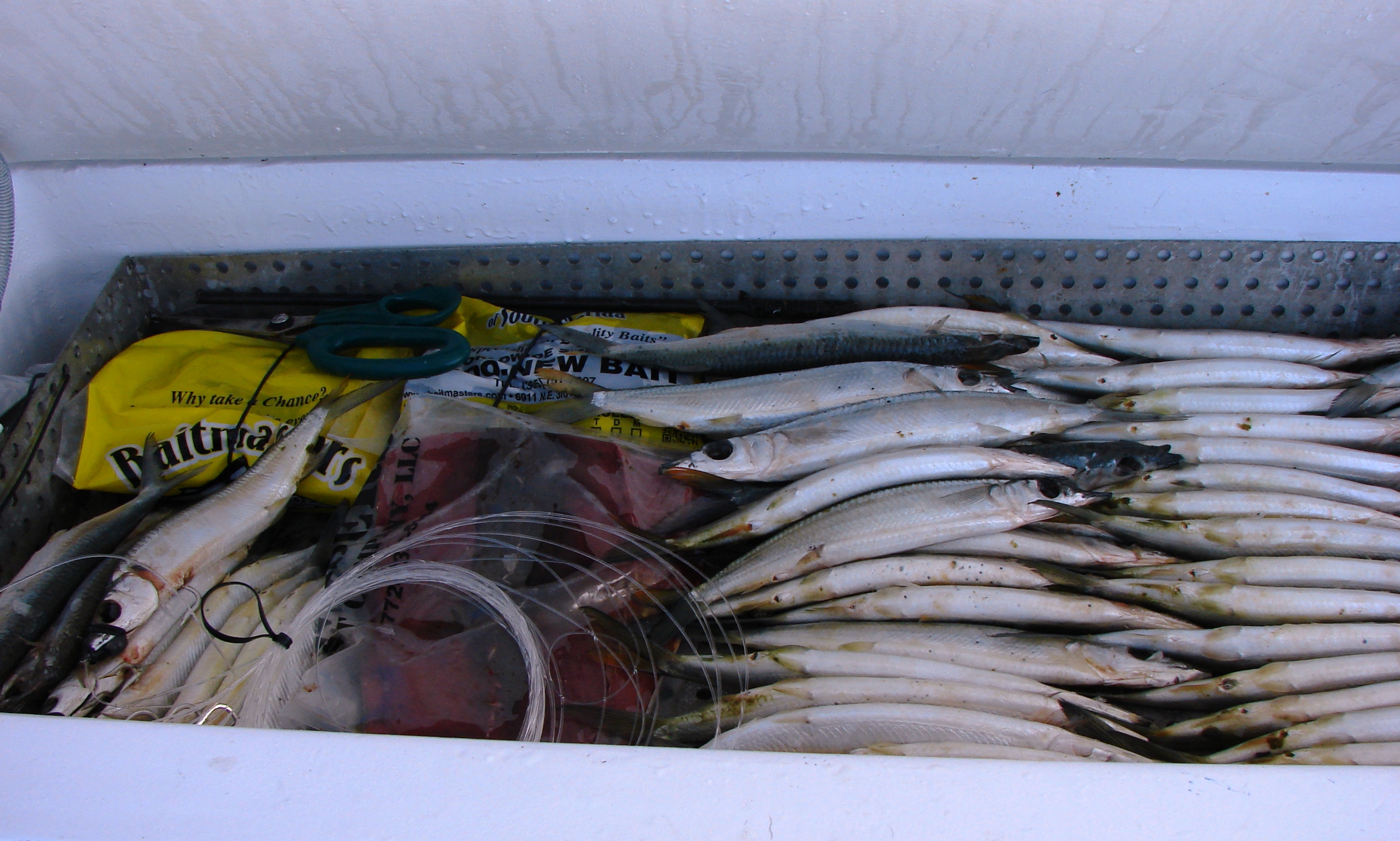
Unique offshore habitat is home to some of the best fishing or yellowfin tuna on the east coast. And late summer is prime time.
The wind was uncommonly calm as Jim Rickman eased the Outer Limits through the sloughs towards Oregon Inlet and turned south. He was setting a course for his 55-foot sportfisher toward a bluewater hot spot known as The Point.
Expectations were high among T.J. Lawson of Winston-Salem, N.C., and friends who had driven in to do battle with tuna. The previous day’s action had been near spectacular, with several nice yellowfins and two large bigeyes, one estimated at 200 pounds. A few of the men dozed anxiously, but the cabin was filled with excited chatter.
In the cockpit, mate Charles Brown checked the rigs and readied several bags of ballyhoo for fast rebaiting when the expected tuna onslaught began. There was also anticipation of encountering a few marauding white marlin.
After a couple of hours, Rickman eased back on the throttles and Brown went to work setting the spread. Several boats were already on site. And a couple of them were hooked up and fighting fish. Rickman felt good as he quickly scanned the horizon and located three schools of feeding tuna cutting across the water and jumping after baitfish.
Brown had eight lines in the water before the first strike. The short outrigger line on the starboard side pulled down. The clip released with a sharp snap, much like the report of a .22 rifle. The rod went down, and the Shimano 50 wide reel buzzed for a few seconds. Unfortunately, the reel quit buzzing, and the rod tip popped back up. The fish had pulled the hook.
Tense moments

The strike and escape happened again on the port transom line. The ballyhoo on both lines had been hit short and crushed, not cut, the signature of a tuna. A third bite led to a bait being pulled off the hook. And finally, as Brown was wrapping a rubber band around the nose of a bait to hold it to the rig, the starboard short rigger popped again. This time the tuna got the hook. The reel kept buzzing.
Lawson grabbed the rod as Rickman continued forward at trolling speed to try to entice another strike. But no other strikes came after a few minutes. So Rickman slowed the Outer Limits to allow Lawson to make headway reeling in his fish.
Lawson was ready for the fight, and after several minutes of pumping and winding, he worked the tiring fish close to the boat. Seeing a flash in the water about 20 feet down, Brown identified the fish as a yellowfin tuna. Smiles quickly spread across the cockpit.
A few minutes later, Lawson wound the small, wind-on swivel through the rod’s guides and Brown leaned across the gunwale with the gaff. Lawson inched the tuna a little closer and Brown struck home with the gaff. He swung the tuna across the transom and directly into the fish box. This 30-pound class yellowfin was the first of the day and had removed the skunk from the boat early on.
Several factors make conditions right for catching tuna
“Water conditions and bait mean everything,” Rickman said. “I like water that is blue to bluish-green and clear. It needs to be warm but not hot. Activity, especially with porpoises or pilot whales, is usually a really good sign. And current is a negative. I prefer to fish in currents of less than 2 knots. Usually, when we find these conditions, we have that classic Oregon Inlet tuna bite.”

Brown said his standard tuna spread is eight surface lines, all set up with wind-on leaders. When fish are marking deep and are reluctant to bite, he adds a planer line. The rods are a mixture of trolling rods and stand ups, primarily with Shimano 50 wides, but a couple with 80 wides. The planer outfit is a bent butt rod with an old 12/0 Penn Senator. He keeps two smaller outfits rigged and ready with naked pitch baits in the event something unexpected shows up in the spread.
Heavy duty gear is essential
The wind-on set ups on the Outer Limits begin with 400 yards of 200-pound braid on the reel. This is tied into several hundred yards of 80-pound mono topshot to a barrel swivel. There is 35 feet of 90-pound fluorocarbon leader between the swivel and the lure. The lures are hand-tied, 1/4-ounce sea witches. Brown, who ties them, said his favorite color is whatever the tuna are biting at the time. The business end uses a Mustad 7692DT hook in the 10/0 size. This is a forged, knife-edge point, with a tapered ring and Duratin finish.
With wind-on leaders, Brown doesn’t have to try to wire a fish and gaff it, too. Anglers reel the fish to the boat, and Brown grabs the leader to swing the fish into gaffing range and position. Once the hook is removed, Brown rebaits that lure and they are quickly fishing with the same color lure that caught the most recent fish.
DESTINATION INFORMATION
HOW TO GET THERE — Oregon Inlet is about 15 miles south of Nags Head, between Bodie Island and Hatteras Island. US 64 is the best access from most points west to Nags Head. US 264 and US 158 are also major roads that head to the Outer Banks from other points in North Carolina. From Nags Head, head south on NC 12 to Oregon Inlet. Popular public boat ramps are at Oregon Inlet Fishing Center, under the US 64/264 bridge between Manteo and Nags Head at on Broad and Mill creeks in Wanchese.
WHEN TO GO — Tuna are in the waters off Oregon Inlet most of the year. Plenty of yellowfins, blackfins and bigeyes spend the summer there.
BEST TECHNIQUES — Heavy equipment is the ticket when trolling for tuna: 50-pound class tackle at least. Reels are spooled with 200-pound braid, with an 80-pound mono topshot and a 90-pound wind-on fluorocarbon leader. Medium to large ballyhoo are trolled behind 1/4-ounce sea witches on 35 feet of 90-pound fluorocarbon leader.
FISHING INFO/GUIDES —Outer Limits Sportfishing Charters, www.fishouterlimits.com, 252-453-3436; Oregon Inlet Fishing Center, 252-441-6301, www.oregon-inlet.com; Pirate’s Cove Marina, 800-367-4728, www.fishpiratescove.com. See also Guides & Charters in Classifieds.
ACCOMMODATIONS — Dare Haven Motel, Manteo, 252-473-2322; Outer Banks Chamber of Commerce, 800-627-3150, www.outerbankschamber.com.
MAPS — Capt. Segull’s Nautical Charts, 888-473-4855, www.captainsegullcharts.com; GMCO’s Chartbook of North Carolina, 888-420-6277, www.gmcomaps.com; Maps Unique, www.offshore-fishing-maps.com, 910-458-9923; The Grease Chart, www.greasechart.com, 252-560-6527.
Click here to read about a South Carolina angler landing a 200+ pound tuna on antique fishing tackle.


